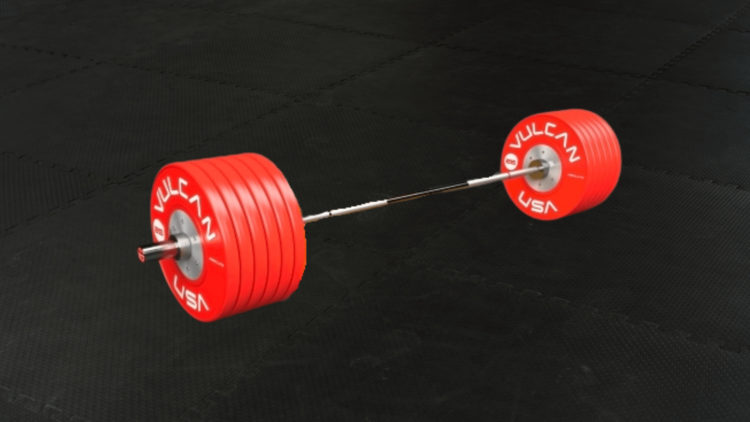
OBJECTIVE OF OLYMPIC WEIGHTLIFTING: Score more points than the competitors by lifting the most combined weight in the “clean-and-jerk” and “snatch” exercises.
NUMBER OF PLAYERS: 14 per weight class (Olympic standard); can vary per competition
MATERIALS: Barbell, weight plates
TYPE OF GAME: Sport
AUDIENCE: 8+
OVERVIEW OF OLYMPIC WEIGHTLIFTING
Olympic weightlifting sees competitors attempt to lift as much weight as possible in the “clean-and-jerk” and “snatch” exercises. While not the traditional strength movements many people are familiar with, these two exercises require inhuman amounts of strength, power, speed, flexibility, and confidence to pull off successfully! Olympic weightlifting is commonly confused with bodybuilding, but the two sports are completely different from each other. In weightlifting, athletes lift as much weight as possible in different methods, while bodybuilding is a competition-based sport purely based on how each contender looks. In this article, we will dive into all the rules and regulations of Olympic weightlifting, from the weight classes to the different methods. Let’s get straight to it!
SETUP

WEIGHT CLASSES
As with most strength sports, competitors must be separated into weight classes to ensure fair competition. These weight classes can vary both in weight and total number depending on the federation that organizes the event. The following weight classes are the ones set for the Olympics.
The five weight classes for competing men:
- 61 kg (134 lbs)
- 73 kg (161 lbs)
- 89 kg (196 lbs)
- 102 kg (225 lbs)
- +102kg (+225 lbs)
The five weight classes for competing women:
- 49 kg (108 lbs)
- 59 kg (130 lbs)
- 71 kg (157 lbs)
- 81 kg (179 lbs)
- +81 kg (+179 lbs)
EQUIPMENT
The only equipment necessary in an Olympic weightlifting competition is a barbell and weight plates. Both of these must be of standardized dimensions:
- An Olympic weightlifting barbell must weigh 44 lbs, measure 7.2 feet in length, and be of appropriate tensile strength.
- Olympic weightlifting plates are of the thick “bumper” variety, allowing them to be safely dropped from a height. These plates range in weight from 1.1 to 55 pounds, with each weight being a different color.
Although not necessary, competitors are encouraged to wear weightlifting belts and heel-elevated shoes, as well as utilize chalk to provide themselves with a better grip on the bar.
GAMEPLAY

THE OLYMPIC LIFTS
Similar to how powerlifting features the three main lifts of bench, squat, and deadlift, Olympic weightlifting features the “snatch” and “clean-and-jerk”. However, unlike most other weight-training movements, these two lifts require immense explosive power and uncanny mobility on behalf of the lifter. While strength is still undoubtedly a factor, technique and efficient execution of these lifts ultimately allow an individual to lift copious amounts of weight above their heads!
THE SNATCH
The snatch sees a competitor hoist a barbell up off the ground and over their head, all in one single motion. In order to complete the movement, athletes often must squat as they’re lifting the bar overhead. The lift isn’t complete until the competitor stands up straight with the barbell overhead.
THE CLEAN-AND-JERK
Utilizing a similar technique to that used for the snatch, the clean-and-jerk sees an athlete hoist a barbell up to their shoulders in one singular motion. Upon the bar reaching their shoulders, competitors often briefly rest and gather themselves before jumping into a split stance (one leg in front and one in back) while pressing the bar overhead.
The lift is complete when the athlete can stand straight and complete the overhead press by locking their elbows out overhead.
JUDGING
Three judges, two on the sides and one in front, are responsible for judging if a competitor properly completes a lift. These judges are responsible for hitting a white light (successful lift) or a red light (failed lift). To be counted as a complete attempt, an athlete must receive at least two white lights.
In terms of judging criteria, judges are looking to ensure a competitor can:
- Fully lock their knees and elbows.
- Hold the locked-out position without any unnecessary movement.
- Only allow their feet to touch the ground.
- Properly drop the barbell.
- And many more specifics.
Most judges are focused on the athlete’s ability to completely lock out the movement, as most athletes will only commit the other technique faults when the weight is clearly too difficult for them to complete.
SCORING
A competitor’s final score is the combined weight total of their successful snatch and clean-and-jerk attempts. These scores are often based on the kilogram weight.
END OF GAME
The competitor with the highest combined total of their successful snatch and clean-and-jerk lifts is the victor of their weight class. If two competitors lift the same amount of weight on a given lift, the tie-breaker goes to the person who first attempted the weight.
- 30 GAMES TO PLAY OVER TEXT - April 22, 2024
- 20+ FREE PRINTABLE BABY SHOWER GAMES - April 16, 2024
- 20+ College Party Games for the Best Night Ever! - April 2, 2024